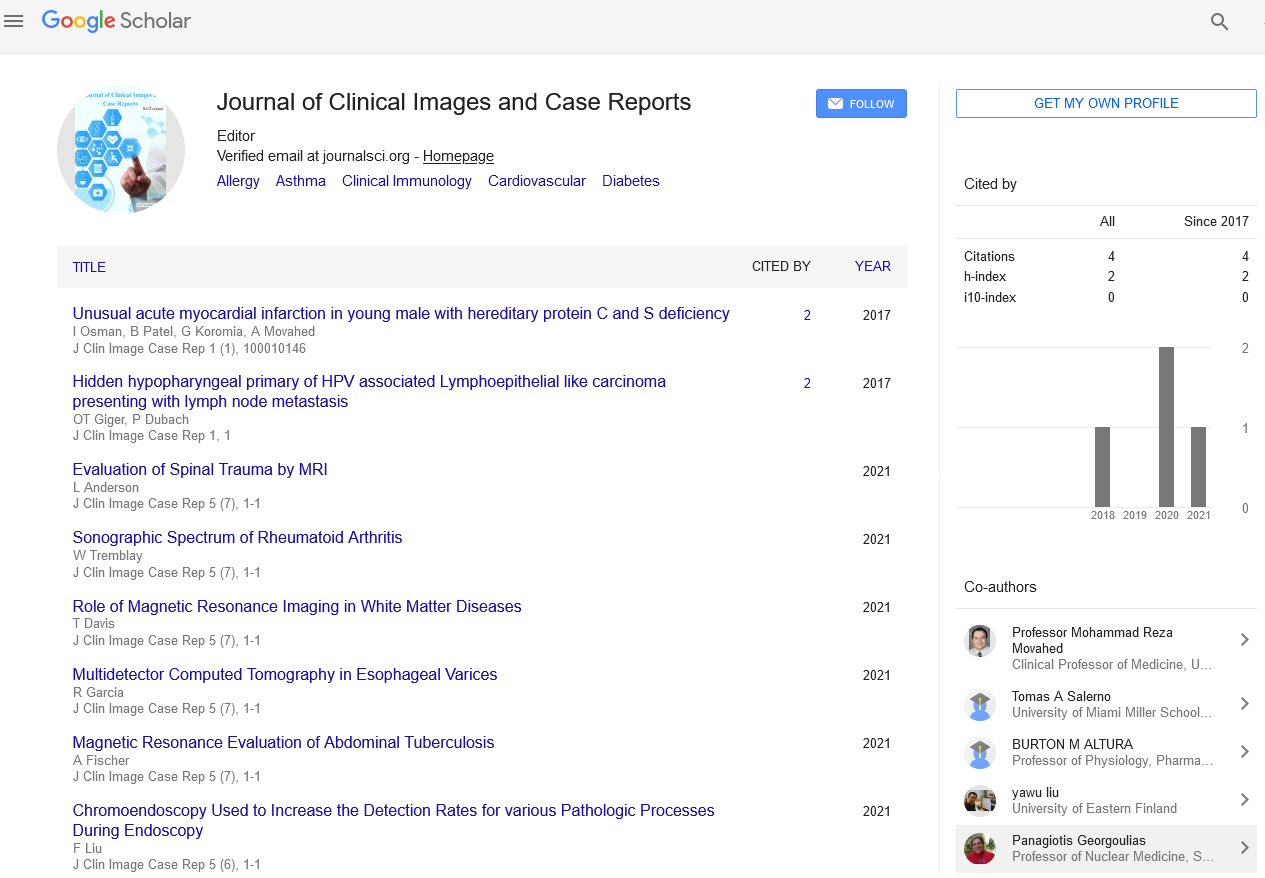Opinion Article, J Clin Image Case Rep Vol: 8 Issue: 4
Clinical and Molecular Mechanisms of Hypogonadism
Horacio Costanzo*
1Department of Endocrinology, Italian Hospital of Buenos Aires, Buenos Aires, Argentina
*Corresponding Author: Horacio Costanzo,
Department of Endocrinology, Italian
Hospital of Buenos Aires, Buenos Aires, Argentina
E-mail: costanzohoracio@gmail.com
Received date: 22 July, 2024, Manuscript No. CICR-24-150614;
Editor assigned date: 24 July, 2024, PreQC No. CICR-24-150614 (PQ);
Reviewed date: 07 August, 2024, QC No. CICR-24-150614;
Revised date: 14 August, 2024, Manuscript No. CICR-24-150614 (R);
Published date: 21 August, 2024, DOI: 10.4172/CICR.1000318
Citation: Costanzo H (2024) Clinical and Molecular Mechanisms of Hypogonadism. J Clin Image Case Rep 8:4.
Description
Hypogonadism is a medical condition characterized by the impaired function of the gonads, which are the testes in males and ovaries in females. These glands produce sex hormones testosterone in males and estrogen and progesterone in females as well as gametes (sperm and eggs). In hypogonadism, the production of these hormones or gametes is reduced or absent, leading to a variety of clinical symptoms related to sexual development, fertility and metabolic health. The condition can be congenital or acquired and may have its origins in the gonads (primary hypogonadism) or the hypothalamic-pituitary axis (secondary or central hypogonadism). A combination of both forms can also occur, known as mixed hypogonadism. Understanding the clinical presentation and molecular mechanisms underlying hypogonadism is different for diagnosis and treatment.
Clinical presentation of hypogonadism
The clinical manifestations of hypogonadism differ between men and women and depend on the onset of the condition whether it occurs before or after puberty as well as its severity. The condition can be classified into primary and secondary forms, with distinct clinical features.
In primary hypogonadism, the problem lies within the gonads themselves, leading to inadequate hormone production despite elevated levels of gonadotropins Luteinizing Hormone (LH) and Follicle-Stimulating Hormone (FSH) from the pituitary gland, which attempt to stimulate hormone production.
Primary hypogonadism in males often manifests with symptoms such as delayed or incomplete puberty, reduced body and facial hair, decreased muscle mass, gynecomastia (development of breast tissue), and infertility. In adult men, primary hypogonadism may cause erectile dysfunction, decreased libido, fatigue, osteoporosis and anemia due to a lack of testosterone. Causes of primary hypogonadism include genetic disorders like Klinefelter syndrome, testicular injury, mumps orchitis and exposure to radiation or chemotherapy.
In women, primary hypogonadism (also known as hypergonadotropic hypogonadism) results in amenorrhea (absence of menstruation), delayed puberty, infertility and menopausal symptoms like hot flashes and vaginal dryness. Genetic conditions like Turner syndrome and Premature Ovarian Insufficiency (POI) are common causes of primary hypogonadism in women. Other factors include autoimmune diseases, chemotherapy and radiation therapy affecting the ovaries.
In secondary hypogonadism, the gonads are normal, but the issue arises from inadequate stimulation by the hypothalamus or pituitary gland. This form of hypogonadism is characterized by low or normal levels of LH and FSH, resulting in reduced sex hormone production.
Secondary hypogonadism can result in similar symptoms as primary hypogonadism, such as delayed puberty, decreased libido, infertility and reduced muscle mass. However, the cause of secondary hypogonadism lies in disruptions in the hypothalamic-pituitary axis. Conditions such as Kallmann syndrome (a genetic disorder characterized by a failure of Gonadotropin-Releasing Hormone (GnRH) neurons to migrate correctly), pituitary tumors, head trauma, and chronic systemic illnesses can impair hormone production from the hypothalamus or pituitary, leading to secondary hypogonadism.
Women with secondary hypogonadism experience amenorrhea, infertility and delayed puberty similar to those with primary hypogonadism. Causes of secondary hypogonadism in women include hypothalamic amenorrhea (due to extreme weight loss, stress, or excessive exercise), pituitary tumors and conditions such as Sheehan’s syndrome, which occurs after severe postpartum hemorrhage and results in pituitary gland damage.
Molecular mechanisms underlying hypogonadism
The molecular mechanisms of hypogonadism are multifaceted, involving genetic mutations, hormonal imbalances and disruptions in the Hypothalamic-Pituitary-Gonadal (HPG) axis. These mechanisms vary between primary and secondary forms of the condition and involve complex interactions among genes, hormones and cellular processes.
Molecular pathways in primary hypogonadism
Primary hypogonadism is often associated with genetic abnormalities that affect gonadal development and function. In males, Klinefelter syndrome (47, XXY) is a common genetic cause of primary hypogonadism. The extra X chromosome in Klinefelter syndrome impairs testicular function, leading to low testosterone levels and elevated gonadotropins. This chromosomal abnormality disrupts spermatogenesis, leading to infertility. Another genetic cause of primary hypogonadism in men is Androgen Insensitivity Syndrome (AIS), where mutations in the androgen receptor gene render tissues unresponsive to androgens, despite normal or elevated levels of testosterone. As a result, affected individuals may develop male internal genitalia but exhibit female external characteristics or ambiguous genitalia.
In females, Turner syndrome (45, X) is a key genetic cause of primary hypogonadism. Women with Turner syndrome lack one of the X chromosomes, leading to ovarian dysgenesis and reduced estrogen production. This results in delayed puberty, amenorrhea and infertility. Another genetic cause of primary hypogonadism in females is Fragile X-associated Primary Ovarian Insufficiency (FXPOI), where carriers of fragile X syndrome (FMR1 gene mutations) experience early ovarian failure.
Hypogonadism is a complex condition with diverse clinical presentations and molecular basis. Primary hypogonadism arises from direct dysfunction of the gonads, often due to genetic disorders like Klinefelter syndrome or Turner syndrome, while secondary hypogonadism involves impaired signaling from the hypothalamicpituitary axis, as seen in conditions like Kallmann syndrome or pituitary tumors. Understanding the genetic and molecular pathways involved in hypogonadism is essential for accurate diagnosis and effective treatment. Advances in genetic research and hormone replacement therapies have improved the management of hypogonadism, offering better outcomes for individuals affected by this condition. However, ongoing research is needed to further elucidate the complex molecular mechanisms driving hypogonadism and to develop more personalized treatment approaches.
 Spanish
Spanish  Chinese
Chinese  Russian
Russian  German
German  French
French  Japanese
Japanese  Portuguese
Portuguese  Hindi
Hindi 